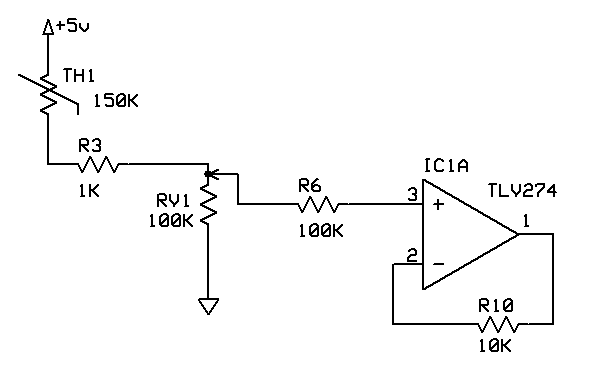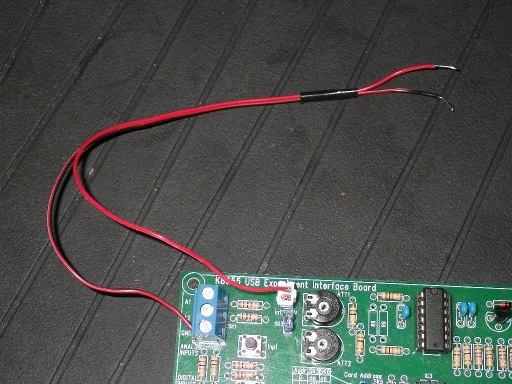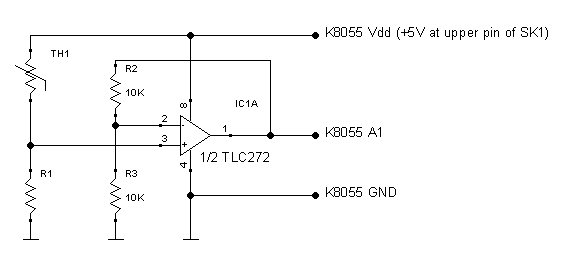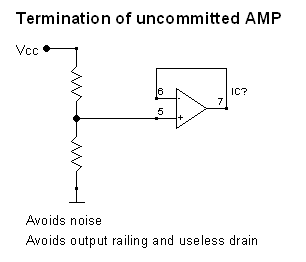[quote=“chrisstubbs67”]Either
In the first few miliseconds the voltage will be amplified to something silly… followed by a small fire
or
Nothing bad will happen, there is no gain resistor on my board (I.e. nothing in R8 or R9 ) on my k8055 board, so from what I have read on the internet about op-amp circuits… so the output will be just below the input[/quote]
An amplifier cannot output more than its supply voltage, which is +5V in this case. If the input voltage (pin 2) times the gain factor exceeds the supply voltage, the amp will “clip”. You can simulate and listen to the result in any good audio editor.
But let’s see how that thermistor would look like in a schematic drawing. Here is the relevant portion of the K8055 schematic with the thermistor connected:

I have drawn RV1 a little “wrong” to illustrate this, because that is how it is actually configured when you have jumper SK2 removed and the potentiometer turned all the way clockwise, which you normally have to measure something on A1.
At 25 degrees, the thermistor TH1 has 150K Ohm resistance. R3 is in series with it, so the two together have 151K. The potentiometer RV1 is between the two main terminals just a simple 100K resistor. And since it is turned fully clockwise, the wiper actually directly connected to R3 without any resistance in between any more. b and RV1 build a classic voltage divider![/b] With +5V going into TH1, the voltage at the wiper, which is the point where R6 connects, is
V = Vdd * RV1 / (TH1 + R3 + RV1)
V = 5 * 100K / (150K + 1K + 100K) = 1.99V
Measure it. If you don’t have one, a good digital multi-meter that can measure Volt, Ampere and Ohms is IMHO a must have for this hobby.
Now those 1.99V go into R6, which is just a current limiter that doesn’t change the voltage. Without R8 the OP-AMP is configured as a voltage follower, so the same voltage that you measured at the middle connector of RV1 will be on pins 2 (input) and 1 (output) of IC1. Pin 1 then also goes directly into the A/D converter. The voltage will rise when it gets warmer as the thermistor will have less resistance, and it will get lower the other way around. Depending on your intended temperature range, this configuration may not use a lot of the available voltage range, but whatever happens, the input voltage into the OP-AMP can never exceed the 0…4.95V range. The measurement may be a little coarse, but this is a working thermometer.
[quote]I’m also thinking I should invest in some software to try out the circuits before I build them…And I’m still waiting for my opamp and bits… I hope they come soon…
By the way if you take out the thermistor and replace it with some electrodes (bare wires) would it make something to measure the skin resistance… i.e. A lie detector? (Ok I’m 44 and still a big kid) or would it be a quick way of getting an electric shock?
Chris[/quote]
I don’t have any simulation software. I just use ExpressSCH to draw the circuit and then try it out. At 47 I still love the try and error method. I think I was 16 when I had the last capacitor exploding, so I trust my math by now.
You won’t get an electric shock from 5V. Skin resistance is somewhere in the mega Ohms. Same circuit, different resistor.
BTW, there is a reason I had that 10K thermistor laying around. It was in the same box as the humidity sensor and the pressure sensor. Get the idea? Measuring humidity will be fun, but requires one more feature in the K8055 Open Source firmware (for the PIC18F). The sensor I have is a Humirel HS1101, which is a variable capacitor that has 173pF at 30%, 180pF at 55% and 191pF at 80% RH. That can be used with a 555 timer to convert relative humidity into a frequency. I already had a bread board setup that produced frequencies around 1400 Hz. Something the PIC18F I am using could easily count on a digital input port. I have not played with the pressure sensor yet.
Regards
Jan




